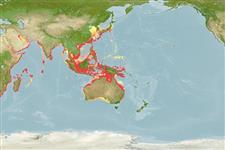Common names from other countries
>
Clupeiformes (Herrings) >
Dorosomatidae (Gizzard shads and sardinellas)
Etymology: Sardinella: Latin and Greek, sarda = sardine; name related to the island of Sardinia; diminutive (Ref. 45335); gibbosa: Named for the country of its type locality: Taiwan..
More on author: Bleeker.
Environment: milieu / climate zone / depth range / distribution range
Ekologi
marina; djupintervall 10 - 70 m (Ref. 12260). Tropical; 41°N - 37°S, 19°E - 155°E
Indo-West Pacific: widespread including the Red Sea, and reported as an invasive species in the eastern Mediterranean basin.
Length at first maturity / Size / Vikt / Age
Maturity: Lm 13.3, range 10 - ? cm
Max length : 29.6 cm TL hane/ej könsbestämd; (Ref. 116943); common length : 15.0 cm SL hane/ej könsbestämd; (Ref. 188); rapporterad maxålder: 7 år (Ref. 1488)
Taggstrålar i ryggfenan (totalt) : 0; Mjukstrålar i ryggfenan (totalt) : 13 - 21; Taggstrålar i analfenan: 0; Mjukstrålar i analfenan: 12 - 23. Total number scutes 32 to 34. Vertical striae on scales not meeting at center, numerous small perforations on hind part of scale. A golden mid-lateral line down flank; dorsal and caudal fin margins dusky; a dark spot at dorsal fin origin. Lower gill rakers 45 to 59 (at 6 to 17 cm standard length, not increasing with size of fish after 6 cm standard length).
Forms schools in coastal waters. Adults feed on phytoplankton and zooplankton (crustacean and molluscan larvae) (Ref. 5213, 5284). Juveniles predominantly prefer crustaceans expanding to include phytoplankton in the diet as their length increases (Ref. 34224). Marketed fresh, dried-salted, boiled or made into fish balls. Possible or even probable confusion with other species (especially S. fimbriata in Indian waters) makes published biological data potentially unreliable.
Stern, N., B. Rinkevich and M. Goren, 2016. Integrative approach revises the frequently misidentified species of Sardinella (Clupeidae) of the Indo-West Pacific Ocean. J. Fish Biol. 89(5):2282-2305. (Ref. 114969)
IUCN Red List Status (Ref. 130435)
CITES (Ref. 128078)
Not Evaluated
Threat to humans
Harmless
Human uses
Fiskeri: kommersiellt viktig
Verktyg
Special reports
Download XML
Internet-källor
Estimates based on models
Preferred temperature (Ref.
115969): 23.6 - 29.1, mean 28.1 (based on 1384 cells).
Phylogenetic diversity index (Ref.
82804): PD
50 = 0.5000 [Uniqueness, from 0.5 = low to 2.0 = high].
Bayesian length-weight: a=0.00851 (0.00695 - 0.01043), b=3.03 (3.00 - 3.06), in cm Total Length, based on LWR estimates for this species (Ref.
93245).
Trofisk nivå (Ref.
69278): 2.9 ±0.30 se; based on food items.
Resiliens (Ref.
120179): Hög, lägsta populationsfördubblingstid mindre än 15 månader (K=0.32-1.8; tmax=7).
Prior r = 1.07, 95% CL = 0.71 - 1.60, Based on 4 data-limited stock assessments.
Fishing Vulnerability (Ref.
59153): Low vulnerability (19 of 100).
Climate Vulnerability (Ref.
125649): Moderate to high vulnerability (47 of 100).
